Moritz Schappler
Adaptive Model-Predictive Control of a Soft Continuum Robot Using a Physics-Informed Neural Network Based on Cosserat Rod Theory
Aug 18, 2025Abstract:Dynamic control of soft continuum robots (SCRs) holds great potential for expanding their applications, but remains a challenging problem due to the high computational demands of accurate dynamic models. While data-driven approaches like Koopman-operator-based methods have been proposed, they typically lack adaptability and cannot capture the full robot shape, limiting their applicability. This work introduces a real-time-capable nonlinear model-predictive control (MPC) framework for SCRs based on a domain-decoupled physics-informed neural network (DD-PINN) with adaptable bending stiffness. The DD-PINN serves as a surrogate for the dynamic Cosserat rod model with a speed-up factor of 44000. It is also used within an unscented Kalman filter for estimating the model states and bending compliance from end-effector position measurements. We implement a nonlinear evolutionary MPC running at 70 Hz on the GPU. In simulation, it demonstrates accurate tracking of dynamic trajectories and setpoint control with end-effector position errors below 3 mm (2.3% of the actuator's length). In real-world experiments, the controller achieves similar accuracy and accelerations up to 3.55 m/s2.
Fast Contact Detection via Fusion of Joint and Inertial Sensors for Parallel Robots in Human-Robot Collaboration
May 13, 2025Abstract:Fast contact detection is crucial for safe human-robot collaboration. Observers based on proprioceptive information can be used for contact detection but have first-order error dynamics, which results in delays. Sensor fusion based on inertial measurement units (IMUs) consisting of accelerometers and gyroscopes is advantageous for reducing delays. The acceleration estimation enables the direct calculation of external forces. For serial robots, the installation of multiple accelerometers and gyroscopes is required for dynamics modeling since the joint coordinates are the minimal coordinates. Alternatively, parallel robots (PRs) offer the potential to use only one IMU on the end-effector platform, which already presents the minimal coordinates of the PR. This work introduces a sensor-fusion method for contact detection using encoders and only one low-cost, consumer-grade IMU for a PR. The end-effector accelerations are estimated by an extended Kalman filter and incorporated into the dynamics to calculate external forces. In real-world experiments with a planar PR, we demonstrate that this approach reduces the detection duration by up to 50% compared to a momentum observer and enables the collision and clamping detection within 3-39ms.
Generalizable and Fast Surrogates: Model Predictive Control of Articulated Soft Robots using Physics-Informed Neural Networks
Feb 04, 2025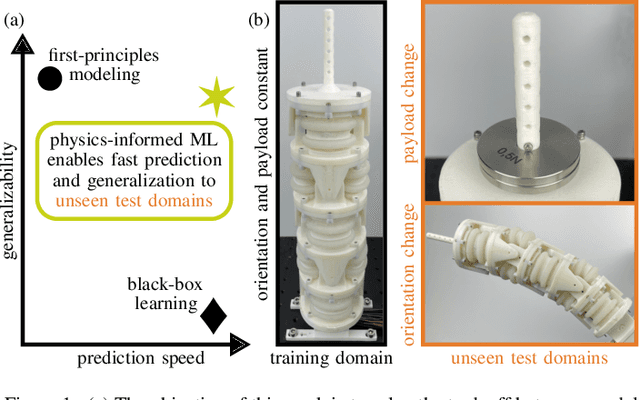
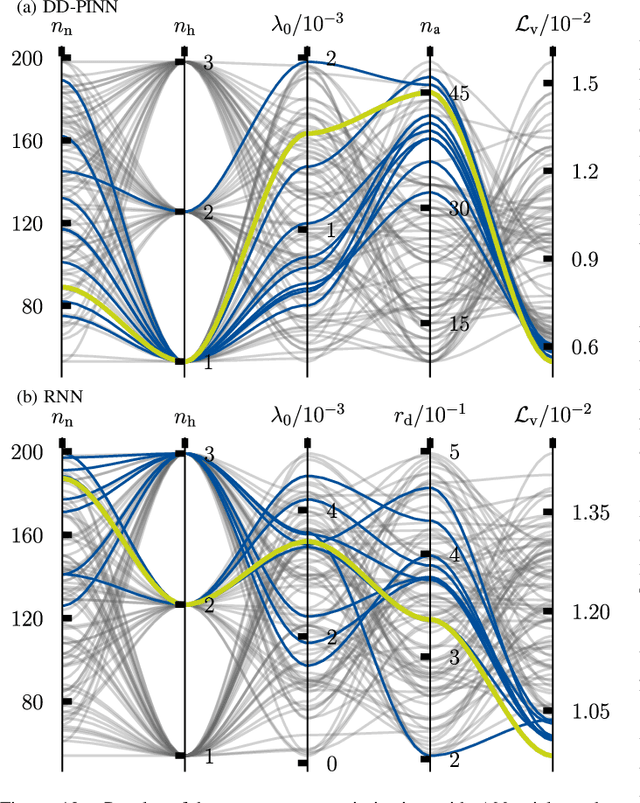
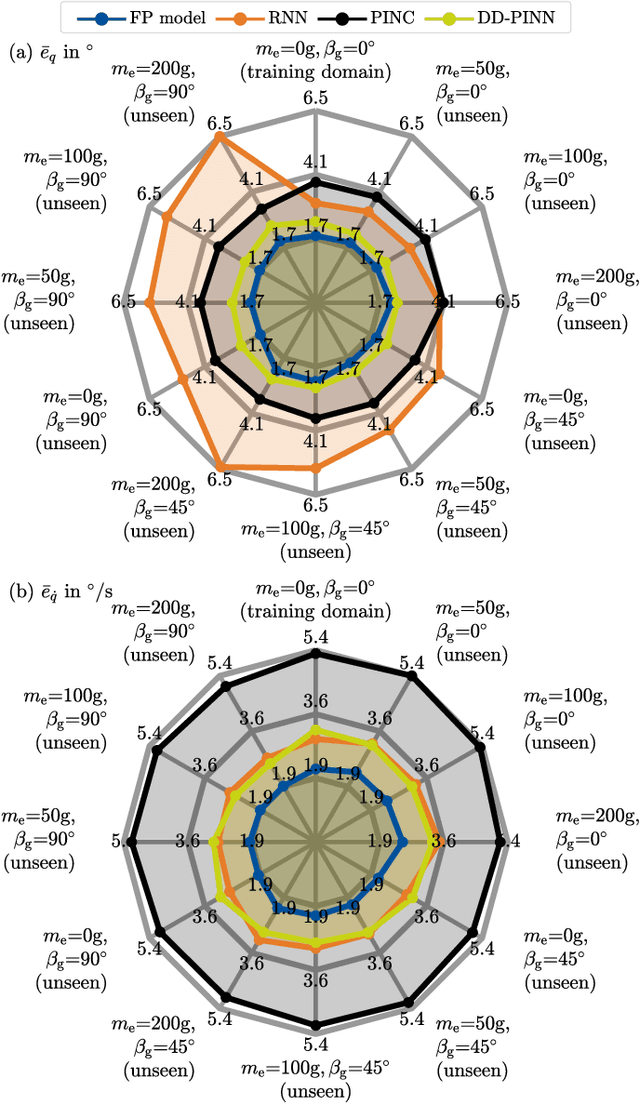
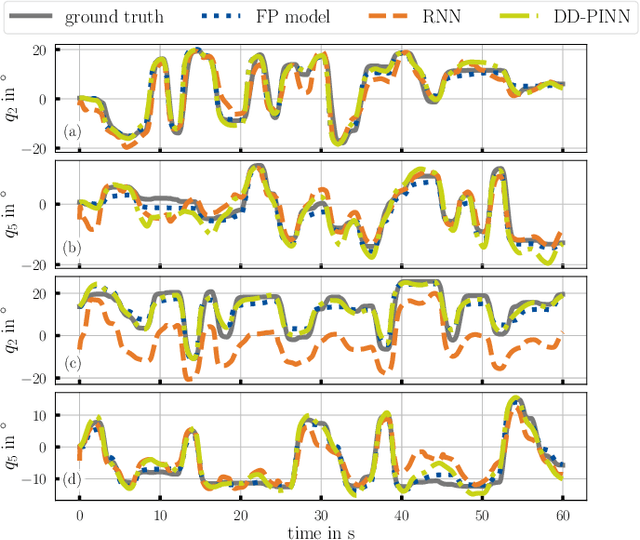
Abstract:Soft robots can revolutionize several applications with high demands on dexterity and safety. When operating these systems, real-time estimation and control require fast and accurate models. However, prediction with first-principles (FP) models is slow, and learned black-box models have poor generalizability. Physics-informed machine learning offers excellent advantages here, but it is currently limited to simple, often simulated systems without considering changes after training. We propose physics-informed neural networks (PINNs) for articulated soft robots (ASRs) with a focus on data efficiency. The amount of expensive real-world training data is reduced to a minimum - one dataset in one system domain. Two hours of data in different domains are used for a comparison against two gold-standard approaches: In contrast to a recurrent neural network, the PINN provides a high generalizability. The prediction speed of an accurate FP model is improved with the PINN by up to a factor of 466 at slightly reduced accuracy. This enables nonlinear model predictive control (MPC) of the pneumatic ASR. In nine dynamic MPC experiments, an average joint-tracking error of 1.3{\deg} is achieved.
SafePR: Unified Approach for Safe Parallel Robots by Contact Detection and Reaction with Redundancy Resolution
Jan 29, 2025



Abstract:Fast and safe motion is crucial for the successful deployment of physically interactive robots. Parallel robots (PRs) offer the potential for higher speeds while maintaining the same energy limits due to their low moving masses. However, they require methods for contact detection and reaction while avoiding singularities and self-collisions. We address this issue and present SafePR - a unified approach for the detection and localization, including the distinction between collision and clamping to perform a reaction that is safe for humans and feasible for PRs. Our approach uses information from the encoders and motor currents to estimate forces via a generalized-momentum observer. Neural networks and particle filters classify and localize the contacts. We introduce reactions with redundancy resolution to avoid type-II singularities and self-collisions. Our approach detected and terminated 72 real-world collision and clamping contacts with end-effector speeds of up to 1.5 m/s, each within 25-275 ms. The forces were below the thresholds from ISO/TS 15066. By using built-in sensors, SafePR enables safe interaction with already assembled PRs without the need for new hardware components.
Learning-based Nonlinear Model Predictive Control of Articulated Soft Robots using Recurrent Neural Networks
Nov 08, 2024Abstract:Soft robots pose difficulties in terms of control, requiring novel strategies to effectively manipulate their compliant structures. Model-based approaches face challenges due to the high dimensionality and nonlinearities such as hysteresis effects. In contrast, learning-based approaches provide nonlinear models of different soft robots based only on measured data. In this paper, recurrent neural networks (RNNs) predict the behavior of an articulated soft robot (ASR) with five degrees of freedom (DoF). RNNs based on gated recurrent units (GRUs) are compared to the more commonly used long short-term memory (LSTM) networks and show better accuracy. The recurrence enables the capture of hysteresis effects that are inherent in soft robots due to viscoelasticity or friction but cannot be captured by simple feedforward networks. The data-driven model is used within a nonlinear model predictive control (NMPC), whereby the correct handling of the RNN's hidden states is focused. A training approach is presented that allows measured values to be utilized in each control cycle. This enables accurate predictions of short horizons based on sensor data, which is crucial for closed-loop NMPC. The proposed learning-based NMPC enables trajectory tracking with an average error of 1.2deg in experiments with the pneumatic five-DoF ASR.
Towards Optimized Parallel Robots for Human-Robot Collaboration by Combined Structural and Dimensional Synthesis
Aug 28, 2024Abstract:Parallel robots (PR) offer potential for human-robot collaboration (HRC) due to their lower moving masses and higher speeds. However, the parallel leg chains increase the risks of collision and clamping. In this work, these hazards are described by kinematics and kinetostatics models to minimize them as objective functions by a combined structural and dimensional synthesis in a particle-swarm optimization. In addition to the risk of clamping within and between kinematic chains, the back-drivability is quantified to theoretically guarantee detectability via motor current. Another HRC-relevant objective function is the largest eigenvalue of the mass matrix formulated in the operational-space coordinates to consider collision effects. Multi-objective optimization leads to different Pareto-optimal PR structures. The results show that the optimization leads to significant improvement of the HRC criteria and that a Hexa structure (6-RUS) is to be favored concerning the objective functions and due to its simpler joint structure.
Domain-decoupled Physics-informed Neural Networks with Closed-form Gradients for Fast Model Learning of Dynamical Systems
Aug 27, 2024Abstract:Physics-informed neural networks (PINNs) are trained using physical equations and can also incorporate unmodeled effects by learning from data. PINNs for control (PINCs) of dynamical systems are gaining interest due to their prediction speed compared to classical numerical integration methods for nonlinear state-space models, making them suitable for real-time control applications. We introduce the domain-decoupled physics-informed neural network (DD-PINN) to address current limitations of PINC in handling large and complex nonlinear dynamic systems. The time domain is decoupled from the feed-forward neural network to construct an Ansatz function, allowing for calculation of gradients in closed form. This approach significantly reduces training times, especially for large dynamical systems, compared to PINC, which relies on graph-based automatic differentiation. Additionally, the DD-PINN inherently fulfills the initial condition and supports higher-order excitation inputs, simplifying the training process and enabling improved prediction accuracy. Validation on three systems - a nonlinear mass-spring-damper, a five-mass-chain, and a two-link robot - demonstrates that the DD-PINN achieves significantly shorter training times. In cases where the PINC's prediction diverges, the DD-PINN's prediction remains stable and accurate due to higher physics loss reduction or use of a higher-order excitation input. The DD-PINN allows for fast and accurate learning of large dynamical systems previously out of reach for the PINC.
SPONGE: Open-Source Designs of Modular Articulated Soft Robots
Apr 16, 2024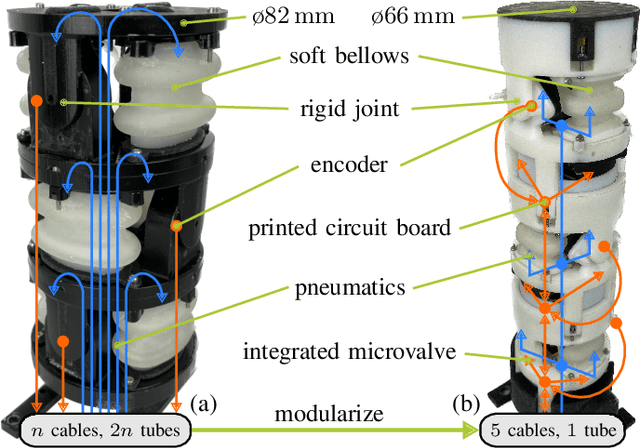
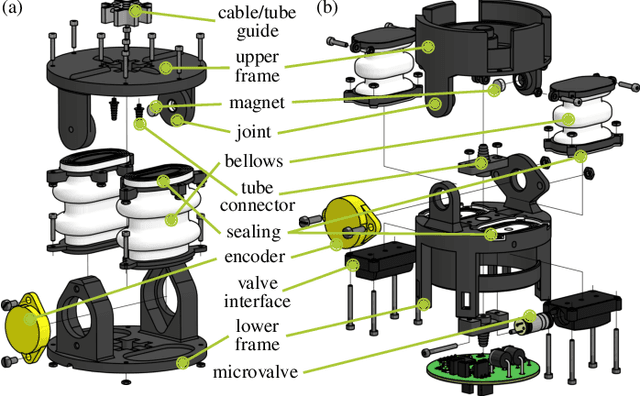
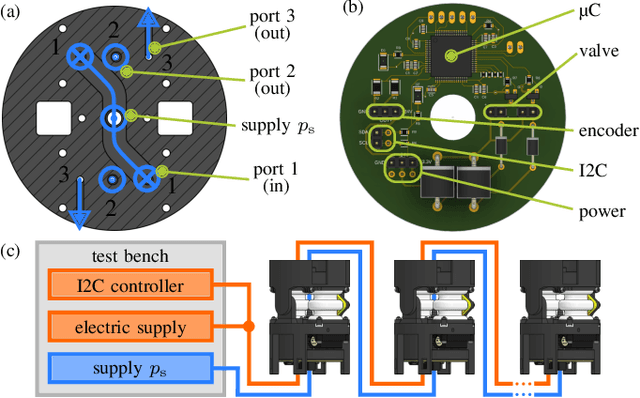
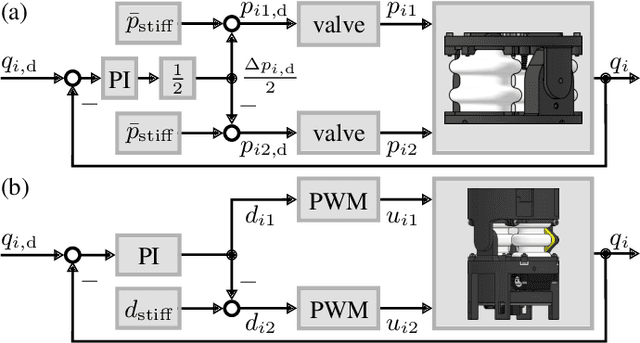
Abstract:Soft-robot designs are manifold, but only a few are publicly available. Often, these are only briefly described in their publications. This complicates reproduction, and hinders the reproducibility and comparability of research results. If the designs were uniform and open source, validating researched methods on real benchmark systems would be possible. To address this, we present two variants of a soft pneumatic robot with antagonistic bellows as open source. Starting from a semi-modular design with multiple cables and tubes routed through the robot body, the transition to a fully modular robot with integrated microvalves and serial communication is highlighted. Modularity in terms of stackability, actuation, and communication is achieved, which is the crucial requirement for building soft robots with many degrees of freedom and high dexterity for real-world tasks. Both systems are compared regarding their respective advantages and disadvantages. The robots' functionality is demonstrated in experiments on airtightness, gravitational influence, position control with mean tracking errors of <3 deg, and long-term operation of cast and printed bellows. All soft- and hardware files required for reproduction are provided.
Quantifying Uncertainties of Contact Classifications in a Human-Robot Collaboration with Parallel Robots
Aug 18, 2023Abstract:In human-robot collaboration, unintentional physical contacts occur in the form of collisions and clamping, which must be detected and classified separately for a reaction. If certain collision or clamping situations are misclassified, reactions might occur that make the true contact case more dangerous. This work analyzes data-driven modeling based on physically modeled features like estimated external forces for clamping and collision classification with a real parallel robot. The prediction reliability of a feedforward neural network is investigated. Quantification of the classification uncertainty enables the distinction between safe versus unreliable classifications and optimal reactions like a retraction movement for collisions, structure opening for the clamping joint, and a fallback reaction in the form of a zero-g mode. This hypothesis is tested with experimental data of clamping and collision cases by analyzing dangerous misclassifications and then reducing them by the proposed uncertainty quantification. Finally, it is investigated how the approach of this work influences correctly classified clamping and collision scenarios.
Towards Human-Robot Collaboration with Parallel Robots by Kinetostatic Analysis, Impedance Control and Contact Detection
Aug 18, 2023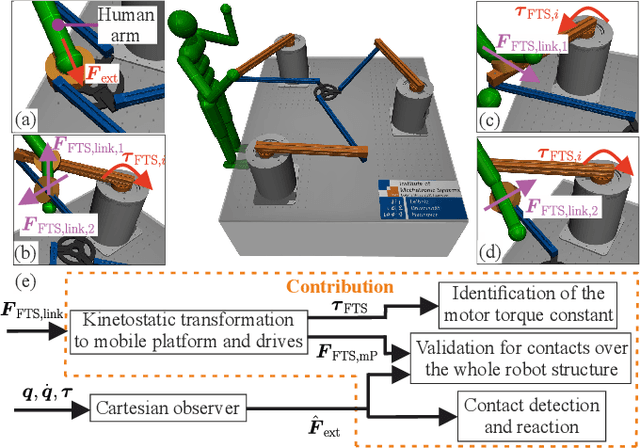

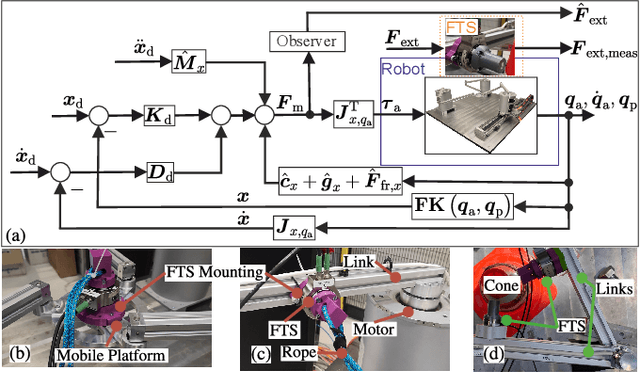
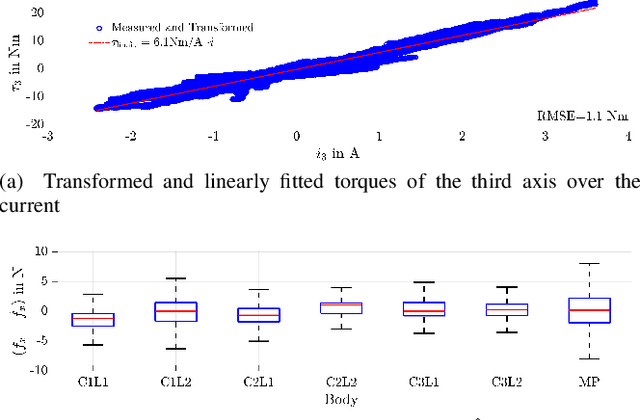
Abstract:Parallel robots provide the potential to be leveraged for human-robot collaboration (HRC) due to low collision energies even at high speeds resulting from their reduced moving masses. However, the risk of unintended contact with the leg chains increases compared to the structure of serial robots. As a first step towards HRC, contact cases on the whole parallel robot structure are investigated and a disturbance observer based on generalized momenta and measurements of motor current is applied. In addition, a Kalman filter and a second-order sliding-mode observer based on generalized momenta are compared in terms of error and detection time. Gearless direct drives with low friction improve external force estimation and enable low impedance. The experimental validation is performed with two force-torque sensors and a kinetostatic model. This allows a new identification method of the motor torque constant of an assembled parallel robot to estimate external forces from the motor current and via a dynamics model. A Cartesian impedance control scheme for compliant robot-environmental dynamics with stiffness from 0.1-2N/mm and the force observation for low forces over the entire structure are validated. The observers are used for collisions and clamping at velocities of 0.4-0.9m/s for detection within 9-58ms and a reaction in the form of a zero-g mode.
 Add to Chrome
Add to Chrome Add to Firefox
Add to Firefox Add to Edge
Add to Edge